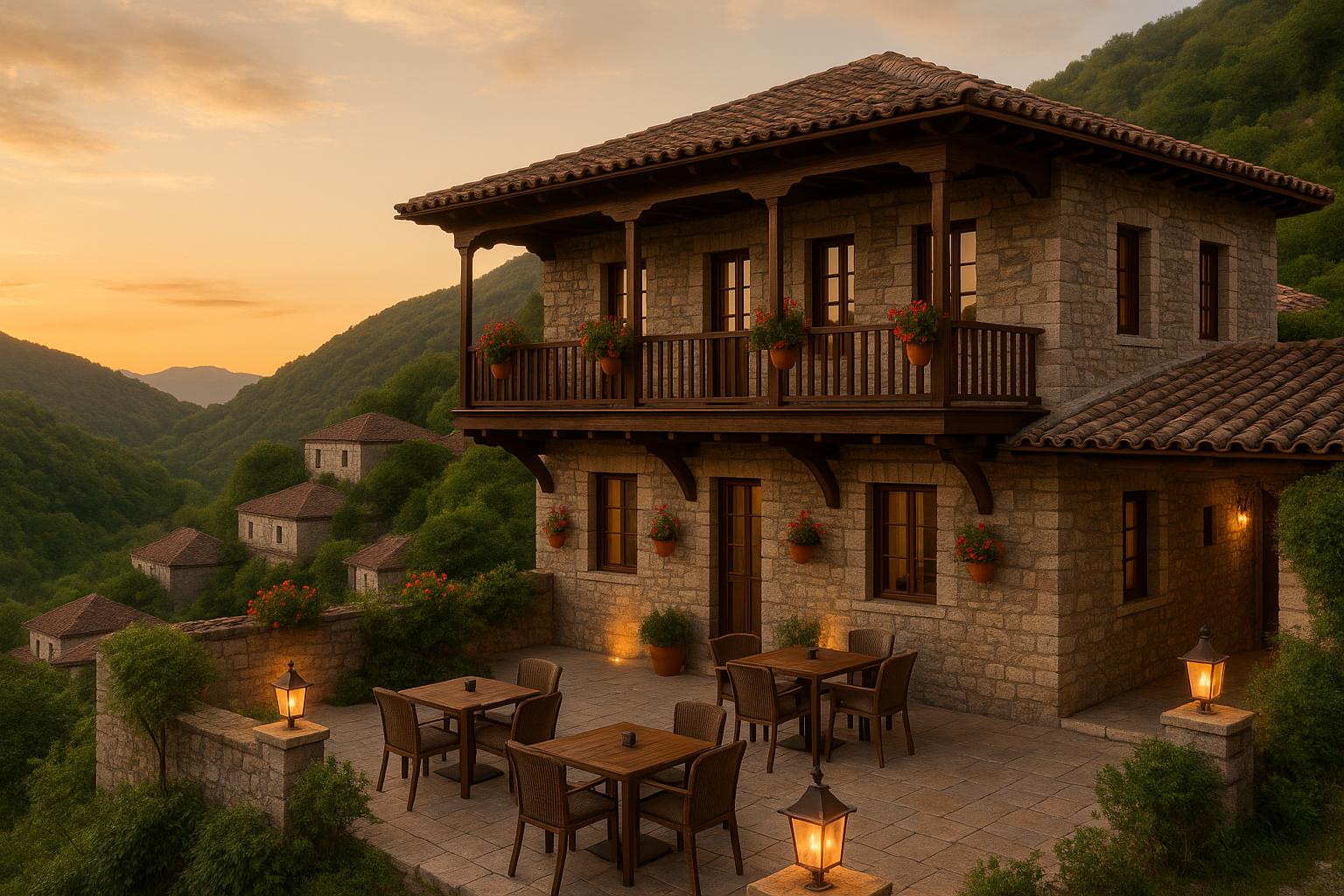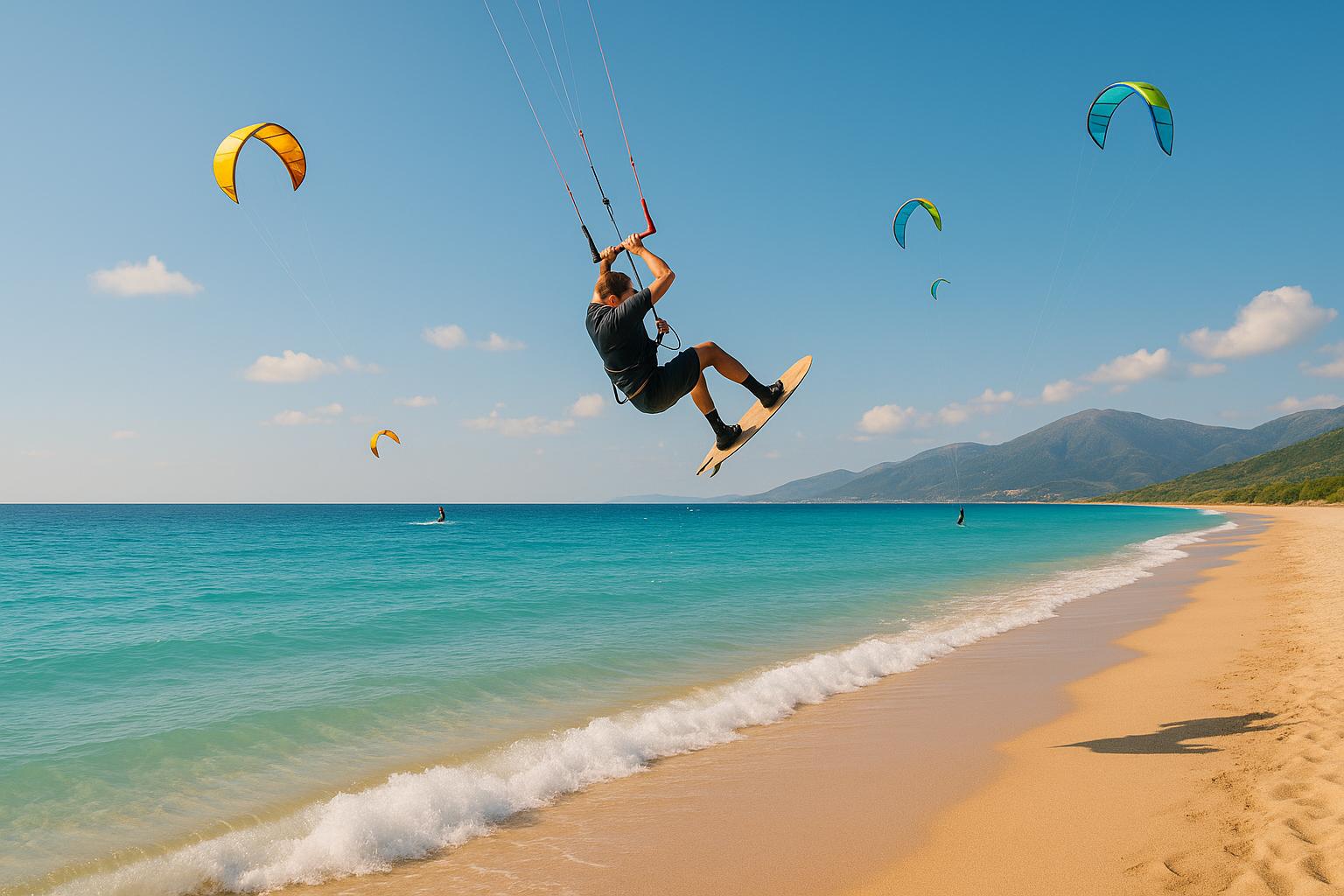Albanian wedding dances are a vibrant way of celebrating unions, blending music, movement, and deep-rooted customs. These dances reflect Albania’s regional diversity, with distinct styles from the north, center, and south. They carry symbolic meanings, such as blessings for prosperity and unity, and often involve traditional instruments like the çifteli, lahuta, and def. Popular dances include Shota, K'cimi of Tropojë, and Vallja e Kuksit, each showcasing unique steps, costumes, and rhythms. Whether you’re a guest or a visitor, these dances offer a glimpse into the shared joy and heritage of Albanian weddings.
Albanian Wedding Magic ✨ Stunning Traditions & Dance | Best Moments!
Main Albanian Wedding Dances
Albanian wedding dances are more than just entertainment - they’re a vibrant expression of heritage, tradition, and celebration. Each dance carries its own story, connecting generations while marking the joyous occasion of a new union. Let’s take a closer look at some of the most cherished dances.
Shota (Shotë)
The Shota is one of the most iconic Albanian wedding dances, especially popular in Kosovo. Traditionally, the bride would wave a handkerchief as she danced, a gesture full of symbolism. The groom would then take the handkerchief and burn it, signifying the transition from single life to marriage. Today, this ritual has evolved into a lively group dance. The couple, joined by their guests, wave handkerchiefs in the air, keeping the spirit of the tradition alive while celebrating together.
K'cimi of Tropojë
Hailing from the rugged mountains of Tropojë in northern Albania, K'cimi is a dance that beautifully conveys themes of courtship and devotion. Dancers wear colorful, richly embroidered northern Albanian attire, adding to the visual spectacle. The dance is known for its intricate arm movements, which symbolize aspirations for prosperity and the strength of partnership. The music, often featuring the lahuta and traditional drums, starts slowly and builds into an electrifying rhythm, mirroring the energy of the dance itself.
Vallja e Kuksit and Valle Pogonishte
These two dances highlight the diversity of Albanian wedding traditions. Vallja e Kuksit, from northern Albania, is all about precision and unity. Dancers form tight circles that expand and contract in harmony with the music, reflecting the structured nature of northern celebrations. On the other hand, Valle Pogonishte, originating from southern Albania, embraces a more open and free-flowing style. Performed in open circles, it allows for individual expression while drawing on musical influences from Greek and Turkish traditions. Both dances are performed in stunning traditional costumes, showcasing intricate local designs and motifs.
Napoleon Dance
The Napoleon Dance has its roots in central Albania, where it began as a way for guests to show their appreciation for the performers by tossing money onto the dancers. Over time, this custom has transformed into a communal celebration. Guests now contribute as a gesture of goodwill and support for the newlyweds, turning the dance into a joyful expression of generosity and shared prosperity.
Dance Structure, Music, and Steps
The rich tapestry of regional dance forms in Albania is beautifully complemented by the music that defines their essence.
Music and Instruments
Albanian wedding celebrations showcase distinct musical styles that vary by region. In the north, ensembles often feature the çifteli, a two-stringed, long-necked instrument integral to Gheg traditions. This instrument is widely played across northeastern Albania, Kosovo, Montenegro, and North Macedonia. Meanwhile, in the south, wedding music takes on a different flavor, with violins and clarinets leading the way. Instruments like the lahutë, a variant of the lute, add depth to the sound, while the def - a large tambourine - provides rhythmic energy. In Kosovo, the def works in harmony with the lodra (big drums) to create a powerful beat, and the zurla, a double-reed horn, enhances the traditional soundscape.
Homemade wind instruments further enrich the musical tradition. The zumarë, resembling a clarinet, and the fyell, similar to a pennywhistle, are often associated with shepherds in northern Albania and evoke a hauntingly melancholic tone. Another standout is the kaba, a style of improvisation typically led by clarinet or violin, supported by accordions and llautës. This style is renowned for its ability to balance fiery emotion with a sense of restraint, capturing the heart of Albanian musical expression.
As Janet Reineck eloquently describes the energy of these celebrations:
"One of the great things about Albanian dance culture is that all you need is a big tambourine, some enthusiastic singers, and you have a dance party – no DJ required! The rhythm from those tambourines will get you up and dancing in one of Kosovo's two basic dance forms: Kcim (duet or solo), and Valle (open circle holding hands)."
These musical traditions do more than set the rhythm - they guide the intricate dance steps that make Albanian wedding celebrations unforgettable.
Symbolism and Social Roles in Wedding Dances
Albanian wedding dances are more than just a form of entertainment - they are a rich tapestry of cultural values, reflecting themes of community, family, and significant life transitions.
Symbolic Meanings
The movements and gestures of these dances often carry deep cultural significance. Take the Shota dance, for example, where the use of a handkerchief symbolizes unity and togetherness. Another example is the K'cimi dance from Tropojë, which originated as part of springtime celebrations. This dance embodies themes of renewal, fertility, and fresh beginnings. In some versions, women wave red handkerchiefs, adding a vibrant visual element to its symbolic narrative.
Gender and Age Group Dynamics
Traditional wedding dances also highlight the roles of different family members and age groups within the community. Elders often lead the way, initiating dance rituals and passing these traditions down to younger generations, as seen in the K'cimi dance. Historically, these roles were quite structured - if an uncle began a dance, only his family members would join in. However, modern practices have become more inclusive, allowing participants from various backgrounds to join. The K'cimi dance, for instance, now welcomes dancers of all ages, who often exchange partners throughout the performance.
These evolving traditions not only preserve cultural identity but also strengthen communal bonds, making each dance a celebration of unity and heritage.
sbb-itb-dfcc1b7
Experiencing Albanian Wedding Dances Today
Albanian wedding dances remain an essential part of modern celebrations, seamlessly blending age-old traditions with contemporary influences. These lively performances not only keep cultural heritage alive but also offer visitors a chance to connect with Albania's rich and colourful customs. Let’s take a closer look at how these traditions are preserved, how visitors can participate, and what to keep in mind as a guest.
Modern Preservation and Changes
In today’s weddings, dedicated folk dance groups often take the stage, performing traditional routines in both indoor and outdoor venues. The music combines the sounds of classic instruments like the çifteli with modern audio systems, creating a unique harmony of old and new. Families frequently document these celebrations, ensuring that the vibrant traditions are passed down to future generations. This blend of tradition and modernity creates an unforgettable experience for both participants and spectators.
Opportunities for Visitors
Visitors to Albania have plenty of opportunities to experience these captivating wedding dances. Local festivities and community events often feature traditional performances, and cultural centres or dance workshops allow travellers to learn the basic steps while exploring the diversity of regional styles. For a more authentic experience, rural areas and mountain villages, especially during the warmer months, host weddings where visitors may witness these traditions up close. Engaging with these celebrations becomes even more meaningful when paired with an understanding of local customs.
Etiquette for Guests
If you’re lucky enough to be invited to participate in a wedding dance, it’s important to respect local traditions. Wait for a family member or host to invite you to join the dance circle. Modest attire is appreciated, and always ask for permission before taking photos to honour the customs. Additionally, familiarising yourself with the tradition of monetary gifts can help you navigate these events gracefully.
Discover Albania for Wedding Experiences

Discover Albania provides travellers with a gateway to authentic cultural experiences, including the joy of Albanian wedding dances. With the help of local guides and cultural workshops, visitors can immerse themselves in these age-old traditions. Offering accommodation options in destinations like Theth and Durrës, Discover Albania curates travel experiences that celebrate Albania’s wedding heritage. By connecting travellers with these treasured customs, Discover Albania plays an important role in keeping this vibrant culture alive.
Conclusion
Albanian wedding dances go far beyond simple entertainment - they are a vibrant expression of centuries-old traditions, strong family ties, and the joy of community gatherings. From distinctive regional styles to the heartfelt money-giving customs, these dances offer a glimpse into Albania's rich cultural tapestry.
Each movement in these dances carries meaning, weaving stories of love, family milestones, and moments of laughter. The lively music and carefully choreographed steps create an atmosphere that Albanian blogger Rudina Bakalli describes as "quite joyful and crazy". These celebrations often stretch late into the night, radiating an energy that leaves a lasting impression on everyone present.
Today’s weddings skillfully combine age-old traditions with modern influences, ensuring that the essence of these rituals endures for generations to come. The money-giving customs, in particular, remain a beloved highlight of the festivities.
Across Albania, these dances serve as a bridge between the past and the present, offering both locals and visitors a chance to connect with the country's values of family, hospitality, and respect. Whether you’re attending a wedding in a remote mountain village or joining a cultural event, the experience is both memorable and meaningful. In Tirana, venues like Albanian Night even host nightly performances where guests can don traditional attire and enjoy authentic reenactments of these treasured customs.
For those eager to immerse themselves in Albania’s wedding traditions, platforms like Discover Albania provide tailored travel guides and boutique accommodations, making it easier to experience these unforgettable celebrations firsthand.
FAQs
What do the gestures in Albanian wedding dances symbolize?
The Symbolism Behind Gestures in Albanian Wedding Dances
Gestures in Albanian wedding dances carry deep meaning, embodying values and traditions passed down through generations. Take, for example, the custom of tossing banknotes over the newlyweds. This act isn't just celebratory; it represents wishes for prosperity, good fortune, and blessings as the couple embarks on their journey together.
Hand movements also play a significant role, often expressing themes of unity, modesty, and the hope for a harmonious marriage. These subtle yet meaningful gestures reflect the couple's bond and the community's collective aspirations for their future.
Another fascinating element is the use of props like handkerchiefs or small towels. These aren't random additions but are tied to traditional courtship rituals. Such gestures might signify flirtation, commitment, or even family honour, emphasizing the strong social and communal ties that are central to Albanian wedding celebrations.
How can tourists experience traditional Albanian wedding dances?
Tourists exploring Albania have the chance to dive into the vibrant world of traditional wedding dances. In Tirana, for example, guided dance lessons offer visitors the opportunity to learn iconic Albanian moves, such as the Valle, a dance that holds deep cultural significance. Beyond lessons, attending local events or live performances often invites participants to join in the energetic celebrations, giving a taste of the joyous spirit of Albanian weddings. These experiences provide a unique way to connect with the local culture while creating lasting memories.
What is the significance of traditional instruments in Albanian wedding dances?
Traditional instruments play a central role in Albanian wedding dances, bringing life and energy to these festive occasions. Key instruments like the zurla (a type of wind instrument), tapan (a large drum), and çifteli (a two-stringed plucked instrument) each add their own unique sound, showcasing the depth of Albania’s musical traditions.
The çifteli stands out as particularly significant, often taking centre stage in wedding celebrations. It symbolizes unity and serves as a proud reminder of Albania’s cultural roots. These instruments do more than just provide music - they create a shared experience, connecting families and guests through the rhythms and melodies that make Albanian weddings unforgettable.


